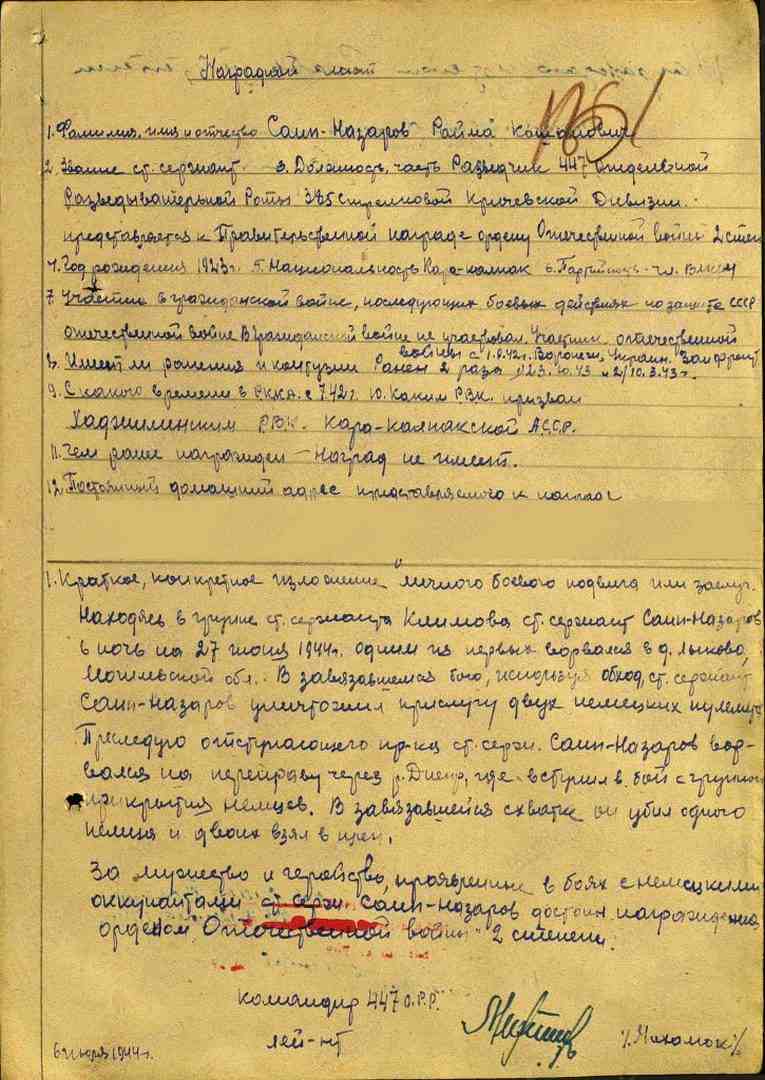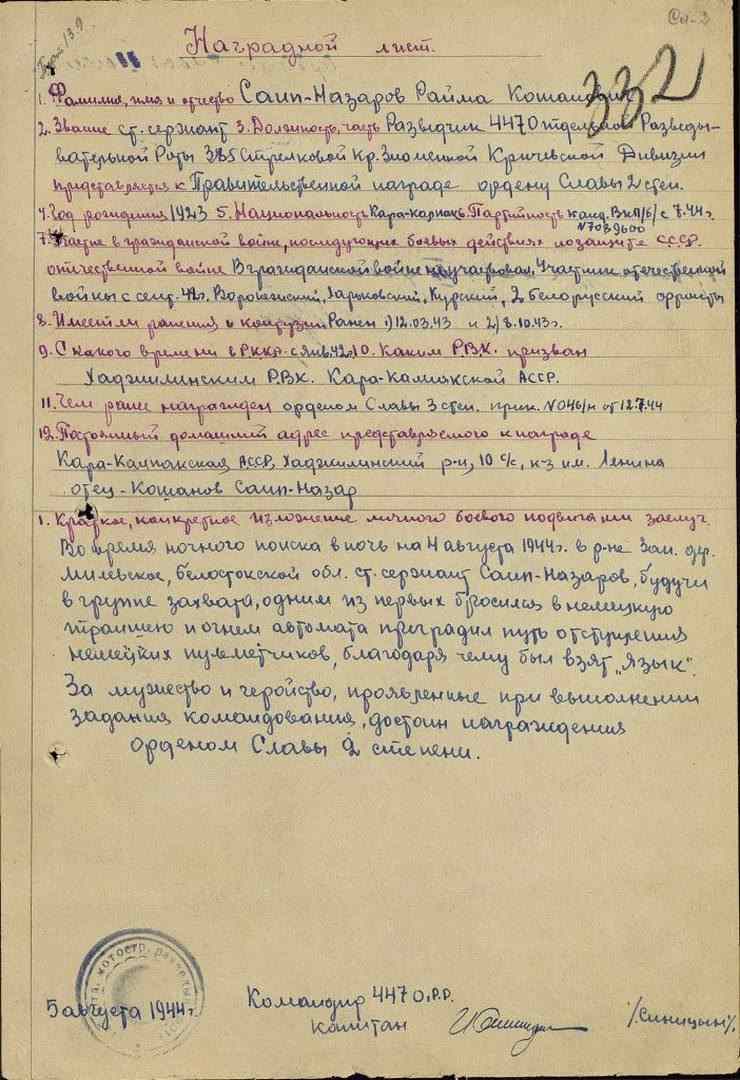
SAIPNAZAROV RAYMO KOSHANOVICH
staff sergeant, a participant in World War II, Full cavalier of the Order of Glory (March 24, 1945)
Born June 5, 1923 in the village of the collective farm named after Lenin of the Khodzhelinsky district of the Karakalpak Autonomous Soviet Socialist Republic in a peasant family. Karakalpak. In 1940 he graduated from incomplete secondary school.
He worked at the collective farm named after Lenin. In January 1940 he was drafted into the Red Army by the Khodzhelinsky regional military registration and enlistment office. For more than six months he was trained in the reserve artillery regiment of the Volga Military District.
Since August 1942, he participated in battles on the Voronezh Front. The combat path began with the commander of the mortar crew of the 748th Infantry Regiment of the 206th Infantry Division. In October 1943, in the battles at the Zadniprovsky bridgehead he was seriously wounded. He spent six months in the hospital. After recovery in April 1944 he was sent to the 2nd Belorussian Front. Enrolled in the 7th reserve artillery regiment, a month later was sent to the 385th rifle division, where he was transferred to divisional reconnaissance, in the 447th separate reconnaissance company.
On the night of June 27, 1944, in a battle for the village of Lykovo (now the Mogilev region of the Mogilev region of Belarus), acting as part of a scout group, he was one of the first to break into the village. In the ensuing battle, he destroyed the calculations of two enemy machine guns. In pursuit of the retreating enemy, he broke into the crossing over the Dnieper River, where he joined the battle with a cover group, they destroyed one Nazi, captured two.
By order of parts of the 385th Infantry Division of July 12, 1944, Senior Sergeant Saipnazarov Raima Koshanovich was awarded the Order of Glory of the 3rd degree.
On the night of August 4, 1944, while searching behind enemy lines near the village of Milevsk (north-west of Białystok, Poland), sergeant Saipnazarov, being in the capture group, rushed into the enemy’s trench, fired the machine gun’s fire with a machine gun, captured one Hitler’s captured.
By order of the 49th Army on September 14, 1944, Senior Sergeant Saipnazarov Raima Koshanovich was awarded the Order of Glory of the 2nd degree.
On the night of October 10, 1944, in the area south of the village of Rozczykha (northeast of the city of Ostroleka, Poland), he overcame the Narew River with scouts, and bursting into the trenches of the enemy engaged in hand-to-hand combat with an enemy machine gunner trying to capture him. A grenade fell into the trench, despite shrapnel wounds to the head and back, it continued to struggle. With the help of comrades who arrived in time, the enemy soldier was captured and taken to the location of the division, where he gave important and valuable information.
By decree of the Presidium of the Supreme Soviet of the USSR of March 24, 1945, for sergeant, courage and fearlessness, shown in battles with the Nazi invaders, Senior Sergeant Raimo Kosipanovich Saipnazarov was awarded the Order of Glory of the 1st degree.
After the hospital he returned to duty. On the eve of the East Prussian operation, he again distinguished himself. On the night of January 12, 1945, near the town of Ostroleka (now the Masovian Voivodeship, Poland), with his group on unsteady ice, he crossed the Narew River and came close to the enemy’s combat guard. As a result of the ensuing battle, the capture group destroyed four German soldiers, and one was captured and taken to the headquarters of the division. For this search received the last award – the Order of the Red Star. From February 12 to 17, 1945, during the East Pomeranian operation, the division waged heavy battles for the settlement of Ose (in the front documents – Osh, now in the Swiecki County, Kuyavian-Pomeranian Voivodeship, Poland), 232 people were killed. One of them was the assistant to the platoon commander of the 447th separate reconnaissance company, senior sergeant Saipnazarov.
He died on February 14, 1945. He was buried in the Grunek farm, and later reburied in one of the military cemeteries in the vicinity (the place was not established).






